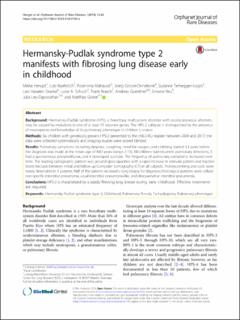| dc.contributor.author | Hengst, Meike | |
| dc.contributor.author | Naehrlich, Lutz | |
| dc.contributor.author | Mahavadi, Poornima | |
| dc.contributor.author | Grosse-Onnebrink, Joerg | |
| dc.contributor.author | Terheggen-Lagro, Suzanne | |
| dc.contributor.author | Skanke, Lars Høsøien | |
| dc.contributor.author | Schuch, Luise A | |
| dc.contributor.author | Brasch, Frank | |
| dc.contributor.author | Guenther, Andreas | |
| dc.contributor.author | Reu, Simone | |
| dc.contributor.author | Ley-Zaporozhan, Julia | |
| dc.contributor.author | Griese, Matthias | |
| dc.date.accessioned | 2022-11-28T14:41:06Z | |
| dc.date.available | 2022-11-28T14:41:06Z | |
| dc.date.created | 2019-02-15T14:37:08Z | |
| dc.date.issued | 2018 | |
| dc.identifier.citation | Orphanet Journal of Rare Diseases. 2018, 13:42 | en_US |
| dc.identifier.issn | 1750-1172 | |
| dc.identifier.uri | https://hdl.handle.net/11250/3034572 | |
| dc.description.abstract | Background: Hermansky-Pudlak syndrome (HPS), a hereditary multisystem disorder with oculocutaneous albinism, may be caused by mutations in one of at least 10 separate genes. The HPS-2 subtype is distinguished by the presence of neutropenia and knowledge of its pulmonary phenotype in children is scarce.
Methods: Six children with genetically proven HPS-2 presented to the chILD-EU register between 2009 and 2017; the data were collected systematically and imaging studies were scored blinded.
Results: Pulmonary symptoms including dyspnea, coughing, need for oxygen, and clubbing started 3.3 years before the diagnosis was made at the mean age of 8.83 years (range 2-15). All children had recurrent pulmonary infections, 3 had a spontaneous pneumothorax, and 4 developed scoliosis. The frequency of pulmonary complaints increased over time. The leading radiographic pattern was ground-glass opacities with a rapid increase in reticular pattern and traction bronchiectasis between initial and follow-up Computer tomography (CT) in all subjects. Honeycombing and cysts were newly detectable in 3 patients. Half of the patients received a lung biopsy for diagnosis; histological patterns were cellular non-specific interstitial pneumonia, usual interstitial pneumonia-like, and desquamative interstitial pneumonia.
Conclusions: HPS-2 is characterized by a rapidly fibrosing lung disease during early childhood. Effective treatments are required. | en_US |
| dc.language.iso | eng | en_US |
| dc.publisher | BioMed Central Ltd. | en_US |
| dc.rights | Navngivelse 4.0 Internasjonal | * |
| dc.rights.uri | http://creativecommons.org/licenses/by/4.0/deed.no | * |
| dc.title | Hermansky-Pudlak syndrome type 2 manifests with fibrosing lung disease early in childhood | en_US |
| dc.type | Peer reviewed | en_US |
| dc.type | Journal article | en_US |
| dc.description.version | publishedVersion | en_US |
| dc.source.volume | 13 | en_US |
| dc.source.journal | Orphanet Journal of Rare Diseases | en_US |
| dc.identifier.doi | 10.1186/s13023-018-0780-z | |
| dc.identifier.cristin | 1677750 | |
| dc.source.articlenumber | 42 | en_US |
| cristin.ispublished | true | |
| cristin.fulltext | original | |
| cristin.qualitycode | 1 | |

